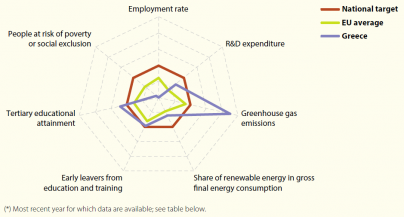Archive:Europe 2020 indicators - Greece
- Data from October 2014. Most recent data: Further Eurostat information, Main tables.
This article is part of a set of statistical articles based on the Eurostat publication Smarter, greener, more inclusive? - Indicators to support the Europe 2020 strategy. It provides recent statistics on the Europe 2020 strategy of the European Union (EU), focusing on the situation in Greece.

Main statistical findings

Partly as a result of the economic downturn, Greece reduced its GHG emissions in non-ETS sectors by 22.4 % until 2012, significantly exceeding its national target of achieving a 4 % reduction by 2020. In 2013, the country also surpassed its target on tertiary education by 2.9 percentage points and was very close to reaching its target on early leavers from education and training. By 2012, Greece had increased its share of renewable energy in gross final energy consumption to 13.8 %, thus narrowing the gap to its 18 % target. In contrast, the rapid fall in employment since 2010 has resulted in Greece having both the lowest employment rate and the largest distance to its employment target in the EU in 2013. The data also reveal a steady rise in the number of people living at risk of poverty or social exclusion since 2010.
Data sources and availability
More information about the origin of the data and the calculation of indicators can be obtained via the Europe 2020 indicators dedicated website.
Under 'Tables', click on the icons next to the indicators:
- 'Explanatory texts (metadata)' for a detailed overview of the collection and compilation methods;
- 'Information on the leaf' for data availability per country.
A more general overview of quality procedures can be found in Implementation of standard reference metadata for indicators - the ESMS Indicator Profile (ESMS-IP) (PDF file).
See also
Further Eurostat information
Publications
- Smarter, greener, more inclusive - indicators to support the Europe 2020 strategy (online publication, also downloadable as PDF file)
Main tables
Dedicated section
Methodology / Metadata
- Towards robust quality management for European Statistics - Communication from the Commission to the European Parliament and the Council COM(2011) 211 final.
Other information
- Regulation 223/2009 of 11 March 2009 on European statistics